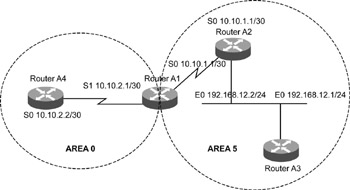OSPF Stub Areas
External routes, which are redistributed into OSPF from other routing protocols, are not allowed to be flooded into a stub area. Routing from a stub area to the rest of the Internet is based on a default route, which is injected by one or more of the ABRs into the area. This section discusses troubleshooting the problems encountered in OSPF stub areas.
Consider the example depicted in Figure 9.6. The figure shows part of an OSPF network with Area 0 and Area 5. Router A1 is the ABR.

Figure 9.6: Part of an OSPF network showing Area 0 and Area 5.
In Figure 9.6, Area 5 is not functioning as the stub area. To troubleshoot this problem, check if all routers in Area 5 are configured as the stub area. The relevant configuration of the routers in Area 5 should be as shown in Table 9.4.
| Router | Configuration |
|---|---|
| A1 | router ospf 1 network 192.168.12.0 0.0.0.255 area 5 network 10.10.2.0 0.0.0.255 area 0 area 5 stub |
| A2 | router ospf 1 network 192.168.12.0 0.0.0.255 area 5 network 10.10.1.0 0.0.0.255 area 5 area 5 stub |
| A3 | router ospf 1 network 192.168.12.0 0.0.0.255 area 5 area 5 stub |
The command area 5 stub is to be necessarily given in all the routers that are part of the stub area. This command is also executed at ABR A1 to become a neighbor to A2.
EAN: 2147483647
Pages: 130